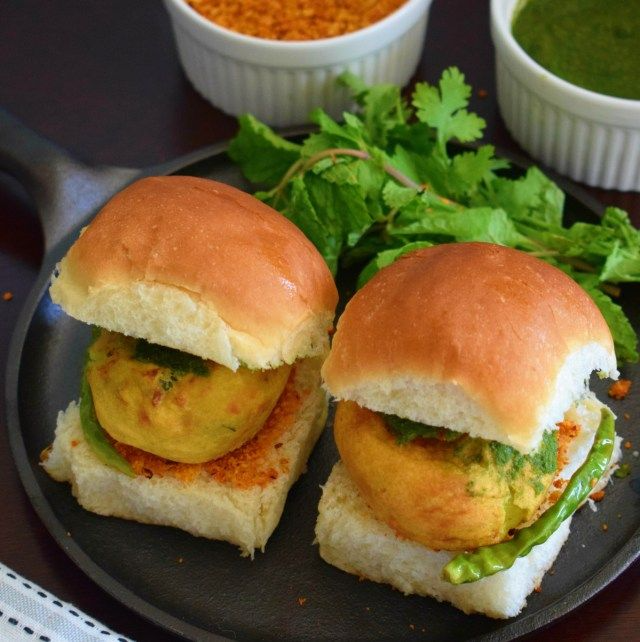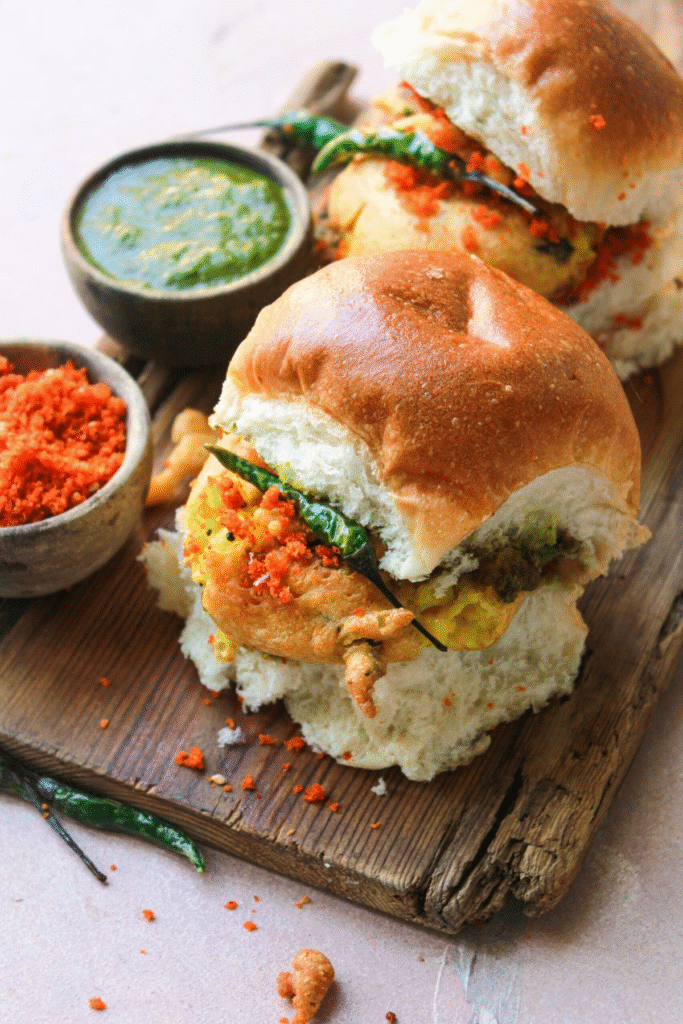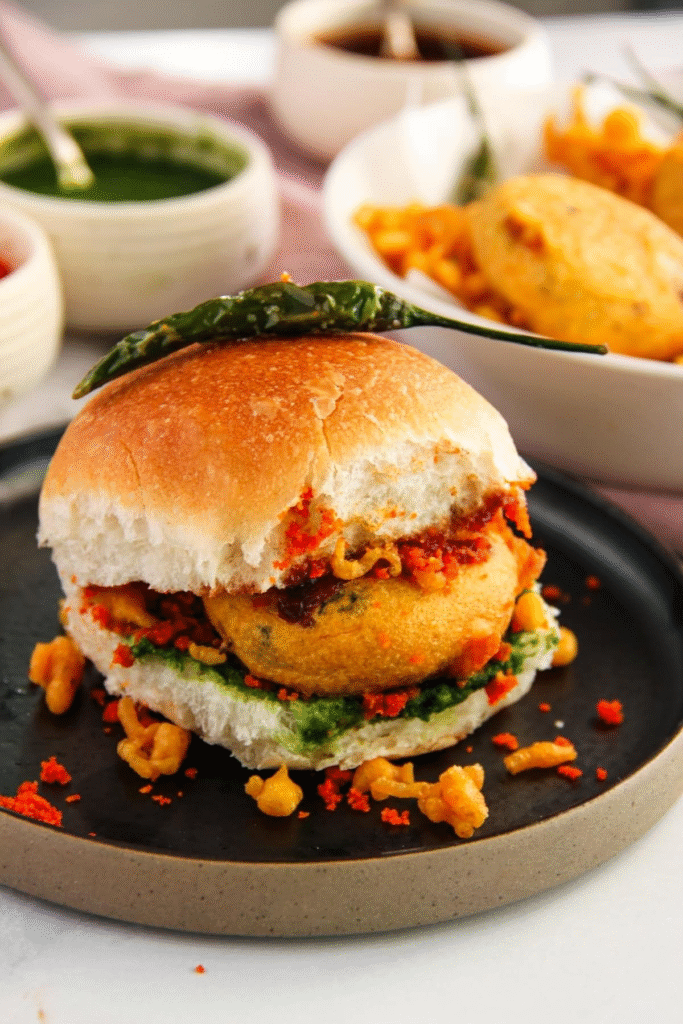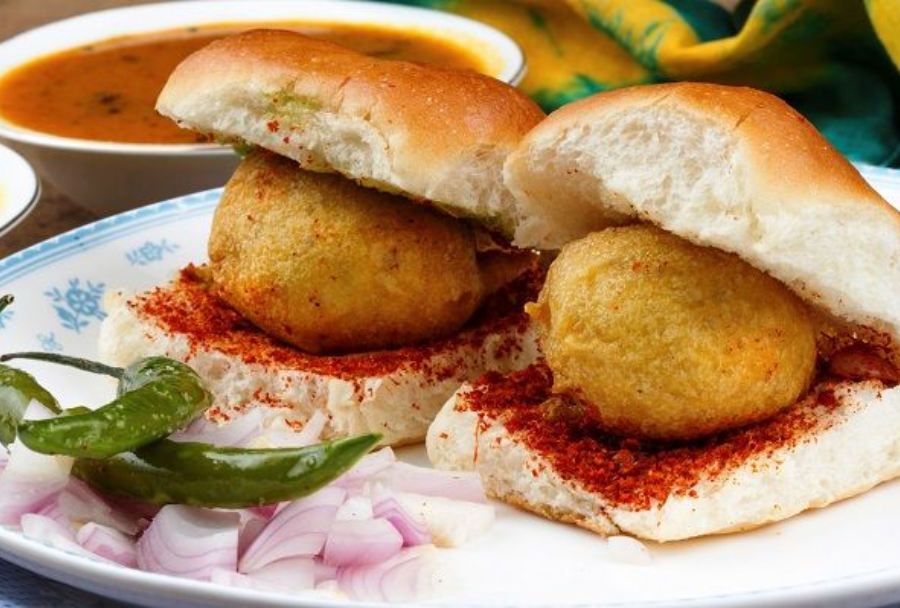Vada Pav — a dish that perfectly captures the spirit of Mumbai’s street food culture. Crispy, spicy potato vada (fritter) sandwiched in a soft pav (bread roll), slathered with chutneys and fried green chilies on the side. A simple yet irresistible snack that has become a culinary icon.
Literally translating to “fritter in bread,” Vada Pav gets its name from its two main components — vada, a spiced potato fritter dipped in gram flour batter and fried, and pav, the soft bread roll.
Few street foods command as much love, loyalty, and cultural pride in India as Vada Pav—a simple yet iconic dish that captures the soul of Mumbai in one spicy, satisfying bite. Often referred to as the “Indian burger,” this humble snack is far more than just bread and potato—it’s a symbol of the city’s resilience, diversity, and flavor-packed street culture. What began as an affordable meal for textile mill workers has grown into a culinary icon that transcends class and region, enjoyed by college students, office-goers, celebrities, and travelers alike.
At first glance, Vada Pav might seem like an uncomplicated snack: a deep-fried spiced potato dumpling (vada) tucked inside a soft, pillowy bread roll (pav), served with a variety of chutneys and a fried green chili.
But to dismiss it as just that would be to miss its magic. Every element of this dish is crafted for impact—from the garlicky, fiery red chutney that coats the pav, to the crispy outer shell of the vada that gives way to soft, masala-infused mashed potato. The textures contrast beautifully—the crunch of the fried batter with the softness of the bun, the heat from the chili, and the tanginess of the chutney all combining to create a burst of flavor in every bite.
Originating in the bustling streets of Mumbai in the 1960s, Vada Pav was the brainchild of Ashok Vaidya, a food vendor near Dadar station. At a time when thousands of blue-collar workers were seeking affordable and filling meals, Vaidya came up with the brilliant idea of placing a spicy batata vada (potato fritter) between slices of pav, making it portable, satisfying, and cheap. It was an instant hit—and over time, what started as a street-side innovation turned into a cultural phenomenon. Today, it is available in every corner of Mumbai, from railway stations to high-end cafes, retaining its identity while evolving with time.
What makes Vada Pav so beloved is not just its flavor but its role in daily life. For many Mumbaikars, it’s more than a snack—it’s breakfast, lunch, or even dinner on a busy day. It’s a quick bite grabbed between meetings, a comfort food after a long commute, or a nostalgic reminder of school canteens and college breaks. The dish carries an emotional resonance; it’s both everyday sustenance and a citywide obsession.
The beauty of this dish lies in its versatility. While the traditional version remains evergreen, countless variations have emerged over the years. Cheese-stuffed vadas, Schezwan-style pavs, butter-toasted buns, mayonnaise dips, and fusion renditions with paneer or even non-veg fillings are now part of the modern Vada Pav landscape. But even with these twists, the heart of the dish—the spicy mashed potato coated in a crisp gram flour batter—remains unchanged, holding true to its street-side roots.
Equally important is the role of chutneys in elevating this dish. A spicy garlic chutney powder, tangy tamarind chutney, and sometimes a cooling mint or coriander chutney all come together to balance the heat of the vada and add layers of complexity. The fiery green chili served on the side is not for the faint of heart, but for those who love it, it’s an essential part of the experience.
Eating Vada Pav is not just about filling your stomach—it’s a sensory experience. The aroma of hot oil from a nearby stall, the sizzle of frying vadas, the chatter of a crowded Mumbai street, and the first crunchy bite of spicy, warm potato all combine into a moment that’s uniquely and unmistakably Indian. It’s affordable, widely available, and yet deeply personal, as everyone has their favorite stall or preferred style of serving it.
In a city that never sleeps, where every minute counts, Vada Pav is the fuel that keeps Mumbai going. It is quick but hearty, inexpensive but rich in flavor, and simple yet full of personality. It’s a dish that belongs to everyone—from the corporate executive to the roadside hawker—and that’s exactly what makes it so special. The story of Vada Pav is the story of Mumbai itself: resilient, flavorful, and full of character.
This guide will walk you through making an authentic yet easy Vada Pav at home, with step-by-step instructions, tips, FAQs, and serving ideas to make your meal unforgettable. There’s something magical about the simplicity of Vada Pav — a dish that effortlessly combines spice, crunch, and comfort. Every bite is a celebration of flavors and textures, making it a must-try for anyone who loves Indian street food.
In this in-depth guide, we’ll not only show you how to make authentic Vada Pav at home, but also dive into its origins, cultural relevance, cooking secrets, regional styles, and nutritional benefits. Whether you’re a home cook or an aspiring chef, this article will give you all the confidence you need to master this beloved dish.
What is Vada Pav?

The term vada refers to the spiced, mashed potato fritter coated in gram flour batter and deep-fried. Pav refers to the pillowy-soft bread roll. Together, they form Mumbai’s answer to the burger — but with a spicy, tangy, and uniquely Indian twist.
Vada Pav is a beloved Indian street food that originated in Mumbai, Maharashtra, and has since become an iconic snack across the country. Often described as the Indian version of a burger, this simple yet flavorful dish consists of a spicy potato fritter (vada) sandwiched between a soft bread roll (pav), typically served with various chutneys and a fried green chili on the side. Despite its modest appearance, Vada Pav is a cultural and culinary phenomenon that captures the spirit of Mumbai’s fast-paced life, its bustling streets, and its love for bold, hearty flavors.
The story of Vada Pav dates back to the 1960s and 70s, when it was introduced as a quick, filling, and affordable meal for the city’s working-class population, especially the mill workers in the Dadar area of Mumbai. According to popular belief, the snack was first created by a street vendor named Ashok Vaidya, who ran a stall outside the Dadar railway station. To cater to the hungry commuters and laborers, he had the ingenious idea of placing a spicy batata vada between slices of pav—a type of soft bread roll introduced by the Portuguese and commonly used in Mumbai bakeries. The result was a convenient, portable snack that quickly gained massive popularity.
At its core, Vada Pav is a study in contrast and balance. The batata vada is made from mashed boiled potatoes that are spiced with green chilies, ginger, garlic, turmeric, mustard seeds, and coriander. This mixture is shaped into balls or patties, dipped in a gram flour (besan) batter, and deep-fried until golden and crisp. The outer shell is crunchy and savory, while the inside is soft and fragrant with spices. The pav is typically sliced open, sometimes lightly buttered or toasted, and layered with one or more chutneys—often a dry garlic chutney, tamarind chutney, or green chutney made with coriander and mint.
A defining element of the dish is the fried green chili served on the side. While optional, many Vada Pav lovers relish the added heat it brings. The dry garlic chutney, often sprinkled directly on the pav or the vada, adds a deep, smoky flavor with just the right amount of spice. Together, these components create a snack that is spicy, salty, tangy, and deeply satisfying.
What makes Vada Pav stand out is its accessibility and its ability to bring people from different walks of life together. From roadside stalls to high-end restaurants offering gourmet variations, Vada Pav appeals to everyone. It is vegetarian, affordable, quick to eat, and extremely flavorful—qualities that have made it a go-to option for millions of people daily. In Maharashtra, especially Mumbai and Pune, it’s not just a snack but an essential part of local identity and culture.
Over time, Vada Pav has evolved into different forms and adaptations. Some versions include cheese, mayonnaise, or even Schezwan sauce for a fusion twist. Others use multigrain or toasted pav, or add salad and pickles. Despite these innovations, the traditional version remains the most popular, holding a special place in the hearts of Mumbaikars and food lovers across India.
Beyond its culinary appeal, Vada Pav symbolizes the resilience and spirit of Mumbai itself. It represents the city’s street food legacy—affordable, fast, tasty, and rooted in everyday life. Whether you’re a student grabbing a quick bite after class, a commuter fueling up before work, or a tourist exploring local flavors, biting into a freshly made Vada Pav is an experience that feels both familiar and unforgettable.
Served best with dry garlic chutney, green chutney, tamarind chutney, and fried green chilies, Vada Pav is as filling as it is flavorful.
History & Cultural Roots
Vada Pav was created in the 1960s in Dadar, Mumbai, by a street vendor named Ashok Vaidya. It was designed as an affordable, quick, and satisfying meal for Mumbai’s busy working class.
Over the decades, it became more than just a snack — it’s now a symbol of Mumbai’s fast-paced life, a political emblem, and a beloved street food enjoyed by people across India and beyond.
Ingredients
For the Vada (Potato Filling):
- 4 medium potatoes, boiled & mashed
- 1–2 green chilies, finely chopped
- 1.5 teaspoons ginger-garlic paste
- 1/2 teaspoon mustard seeds
- 8–10 curry leaves
- 1/4 teaspoon turmeric powder
- 2–3 tablespoons oil
- Salt, to taste
- Fresh coriander, chopped
For the Batter:
- 1 cup besan (gram flour)
- 1/4 teaspoon turmeric powder
- 1/4 teaspoon baking soda
- Salt, to taste
- Water, as needed
For Assembling:
- 8 pav (bread rolls)
- Dry garlic chutney
- Green chutney (optional)
- Tamarind chutney (optional)
- Fried green chilies
Cooking Science: Why It Works
The starch in potatoes gives the vada its creamy interior while the besan batter fries up to a crispy, golden crust. The contrast of soft pav, spicy chutneys, hot vada, and crispy chilies creates a perfect bite every time.
Pro Tips Before You Start
✅ Fry vadas in hot oil (around 350°F/175°C) for a crisp crust.
✅ Make chutneys in advance — they enhance flavor and convenience.
✅ Use fresh, soft pav for best results.
✅ Fry green chilies quickly and salt them lightly.
Step-by-Step Recipe with Captions

Step 1: Make the Potato Filling
[mashed potato mixture with spices in a bowl]
Heat oil, crackle mustard seeds, add curry leaves, green chilies, ginger-garlic paste, and turmeric. Add mashed potatoes and salt. Mix well. Cool slightly and shape into balls.
Step 2: Make the Batter
[thick besan batter in a bowl]
In a bowl, mix besan, turmeric, salt, and baking soda. Gradually add water to make a thick, smooth batter.
Step 3: Fry the Vadas
[vadas frying in hot oil]
Heat oil in a kadhai. Dip potato balls into batter and fry until golden brown. Drain on paper towels.
Step 4: Toast the Pav
[pav buns being toasted on a tawa]
Slit pav horizontally. Toast on a tawa with a little butter.
Step 5: Assemble & Serve
[vada pav served with chutneys and fried chili]
Spread garlic chutney and green chutney on pav. Place a hot vada in the middle, press gently, and serve with fried chili.
Watch the Video Tutorial
Prefer to watch step-by-step? Here’s a video that shows you how to make authentic Vada Pav easily:
➡️ Watch Vada Pav Video Tutorial
Serving Suggestions
✅ Serve hot with extra garlic chutney on the side.
✅ Pair with cutting chai for the ultimate Mumbai snack experience.
✅ Add tamarind chutney for a tangy twist.
✅ Serve with fried green chilies for spice lovers.
Regional Variations
Mumbai Style
Classic — spicy garlic chutney, fried chilies, no extras.
Pune Style
Slightly milder with sweetish tamarind chutney.
Modern Variations
Cheese vada pav, schezwan vada pav, mayo vada pav.
Nutritional Profile (per serving)
Calories: ~280
Carbs: ~40g
Protein: ~5g
Fat: ~10g
Vegetarian, and can be made vegan with oil and vegan pav.
Extended FAQs

Q: Can I bake the vada instead of frying?
A: You can, but the texture won’t be as crisp and authentic.
Q: Can I use other fillings?
A: Yes — experiment with paneer, mixed vegetables, or even sweet potato.
Q: How long does it stay fresh?
A: Best eaten fresh, but you can store vadas for a day and reheat in an oven.
Q: Can I make it less spicy?
A: Reduce green chilies and skip fried chilies for a milder version.
Storage & Reheating
✅ Store vadas in fridge for up to 2 days.
✅ Reheat in oven or air fryer for crispness.
✅ Toast pav fresh every time.
Why This Recipe Works
✅ Authentic street food flavor at home.
✅ Perfect balance of textures and spice.
✅ Easy to make with everyday ingredients.
✅ Comforting and satisfying.
Conclusion
Vada Pav is more than just a snack — it’s Mumbai’s soul served on a plate. Simple yet bursting with flavor, it embodies the spirit of India’s vibrant street food culture.
With this recipe, you can bring the taste of Mumbai into your kitchen. Cook fresh, serve hot, and enjoy — because nothing says Mumbai like a spicy Vada Pav with a cup of chai.
A humble bun. A fiery fritter. A love story that never gets old — that’s the magic of Vada Pav.


